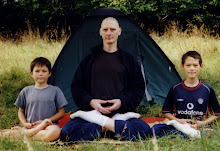KO-IN: Light & Shade -- Precious Time

.JPG)
The above five Chinese characters, in their Chinese-sounding readings, are:
(1) MAKU Do not
(2) KO emptily, in vain
(3) DO traverse
(4) KO light
(5) IN shade, yin
KO-IN light & shade, day & night, means precious time.
In English, the natural order of elements would be similar to the Chinese: 1, 3, 4-5, 2 : "Do not pass precious time in vain." Keeping the order of the Chinese wouldn't sound too strange, either: "Do not vainly pass precious time."
But in Japanese the characters are read in a very different order 2, 4-5, 3, 1
(2) MUNASHIKU in vain
(4-5)KO-IN precious time
O [object particle]
(3) WATARU traverse [verb]
KOTO thing [makes WATARU into a noun]
(1) NAKARE Don't do it
MUNASHIKU KO-IN O WATARU KOTO NAKARE
"Do not waste precious time."
In Master Dogen's thoughts, a moment spent in genuine enjoyment of sitting-zen is never a wasted moment.
Master Dogen wrote the five characters shown above in classical Chinese style. It would be a bit like an English Christian monk of that time writing monastic rules in Latin. But when those Chinese characters are read out loud, they are read in Japanese, by adding the grammatical inflections KOTO and O, and by changing the order.
Master Dogen wrote Shobogenzo itself in Japanese, although the Japanese includes many quotations in the form of blocks of Chinese characters.
It is ironic that our desire to get to the bottom of Master Dogen's teaching can involve us in troublesome discussion like this -- which Master Dogen himself compared to counting grains of sand on a beach.
At the same time, if you are like me, you will feel a certain satisfaction in the sense of getting it straight from the horse's mouth.
These are Master Dogen's words written, we think in his own hand around 1227. And they are exactly the same words that appear in the later version of Fukan-zazengi as well.
Master Dogen exhorted us, over and over again, not to pass precious time in vain.

.JPG)


0 Comments:
Post a Comment
<< Home